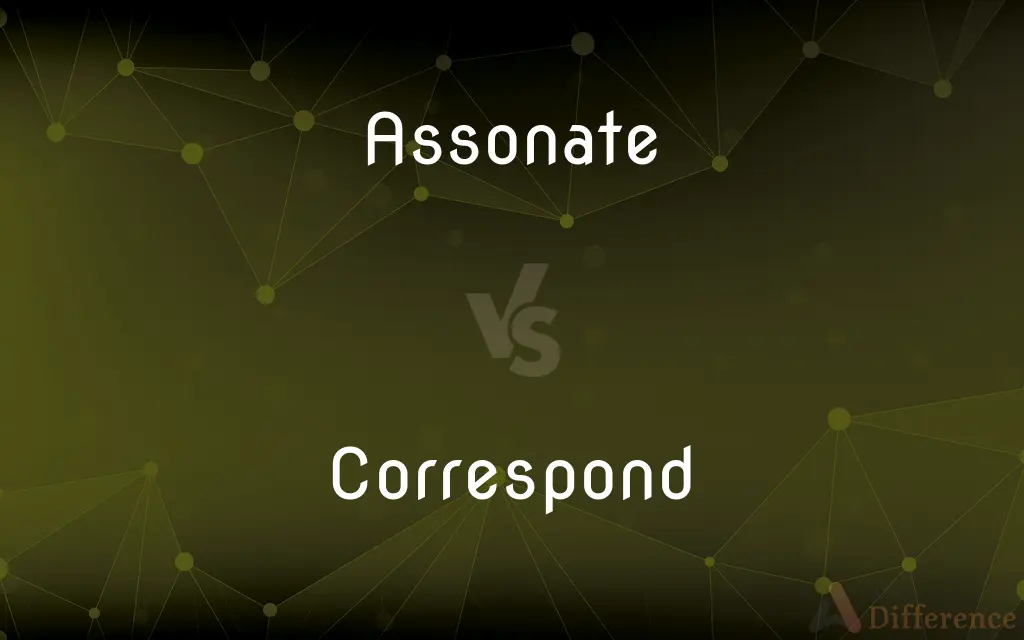Assonate vs. Correspond — What's the Difference?
By Maham Liaqat & Urooj Arif — Updated on April 4, 2024
Assonate involves the repetition of vowel sounds in poetry, while correspond means to have a close similarity, match, or agreement.

Difference Between Assonate and Correspond
Table of Contents
ADVERTISEMENT
Key Differences
Assonance, in poetry, is the repetition of vowel sounds in nearby words to create internal rhyming within phrases or sentences, enhancing musicality and mood. Correspond, however, refers to a situation where two or more things are similar, match, or are equivalent in some way, often used outside the context of literature.
While assonance is a literary device used to add rhythm and musicality to texts, making language more expressive and memorable, correspond can apply to a wide range of scenarios, from objects that match in color to ideas that are similar, or people who communicate with each other.
The purpose of assonance is primarily artistic, serving to embellish prose or poetry through sound repetition. In contrast, correspondence can denote communication between individuals or entities and also the idea of things being in harmony or agreement due to their similarities.
Assonance is a specific term with a narrow application, primarily found in the study of poetry and literature. On the other hand, correspond is a versatile verb or adjective that appears in various contexts, including personal communications, scientific comparisons, and discussions of similarity or equivalence.
Both terms describe relationships, but their domains are distinct: assonance focuses on the aesthetic connection between sounds within texts, enhancing the reader's experience, while correspond deals with similarity, agreement, or communication, covering a broad spectrum of uses from personal to academic.
ADVERTISEMENT
Comparison Chart
Definition
Repetition of vowel sounds in poetry.
To have similarity, match, or agreement.
Usage Context
Literary, specifically in poetry.
Broad, including communication and comparison.
Purpose
Enhance musicality and mood in texts.
Indicate similarity or communication.
Application
Artistic, to beautify language.
Versatile, used in various contexts.
Focus
Aesthetic connection between sounds.
Similarity, agreement, or communication.
Compare with Definitions
Assonate
The repetition of vowel sounds in close proximity within a line of poetry or prose.
The poet used assonance to create a soft, harmonious sound in the verse.
Correspond
To be in agreement, similarity, or harmony with something else.
The two theories correspond closely, suggesting a shared underlying principle.
Assonate
Utilized by poets and writers to add musicality and rhythm to their works.
Her latest poem assonates with the long i sound for a melancholic effect.
Correspond
Indicates a connection or relationship between people, ideas, or objects.
The patterns on the vase correspond with those found in ancient artifacts.
Assonate
Primarily found in poetry and creative writing.
Classic poetry often employs assonance as a key element of its style.
Correspond
Applied in various contexts, from personal communications to scientific observations.
Please correspond with the team leader to get the latest project updates.
Assonate
Enhances the aesthetic and emotional appeal of language.
The assonance in the speech added a lyrical quality that captivated the audience.
Correspond
Can denote communication between individuals or entities.
They corresponded for months before finally meeting in person.
Assonate
A literary device that contributes to the overall mood and tone of a piece.
To evoke a sense of peace, he frequently assonated using the oo sound.
Correspond
Used across disciplines, from mathematics to personal relationships.
The data from the experiment correspond to the initial hypothesis.
Assonate
To correspond in (particularly vowel) sounds.
Part of the magic of her poetry was her ability to have her words assonate in the most propitious places.
Correspond
To be in agreement, harmony, or conformity.
Assonate
To correspond in sound.
Correspond
To be similar or equivalent in character, quantity, origin, structure, or function
English navel corresponds to Greek omphalos.
Assonate
Correspond in vowel sounds; rhyme in assonance;
The accented vowels assonated in this poem
Correspond
To communicate by letter, usually over a period of time.
Correspond
To be equivalent or similar in character, quantity, quality, origin, structure, function etc.
Correspond
To exchange messages, especially by postal letter, over a period of time.
I've been corresponding with my German pen pal for three years.
Correspond
To be like something else in the dimensions and arrangement of its parts; - followed by with or to; as, concurring figures correspond with each other throughout.
None of them [the forms of Sidney's sonnets] correspond to the Shakespearean type.
Correspond
To be adapted; to be congruous; to suit; to agree; to fit; to answer; - followed by to.
Words being but empty sounds, any farther than they are signs of our ideas, we can not but assent to them as they correspond to those ideas we have, but no farther.
Correspond
To have intercourse or communion; especially, to hold intercourse or to communicate by sending and receiving letters; - followed by with.
After having been long in indirect communication with the exiled family, he [Atterbury] began to correspond directly with the Pretender.
Correspond
Be compatible, similar or consistent; coincide in their characteristics;
The two stories don't agree in many details
The handwriting checks with the signature on the check
The suspect's fingerprints don't match those on the gun
Correspond
Be equivalent or parallel, in mathematics
Correspond
Exchange messages;
My Russian pen pal and I have been corresponding for several years
Correspond
Take the place of or be parallel or equivalent to;
Because of the sound changes in the course of history, an 'h' in Greek stands for an 's' in Latin
Common Curiosities
Can "correspond" be used in scientific contexts?
Yes, in scientific contexts, "correspond" can describe how observations, data, or theories are in agreement or match with each other.
How does correspondence function in personal relationships?
In personal relationships, correspondence often refers to communication through letters, emails, or messages, helping maintain and build connections over distances.
What is assonance in literature?
Assonance is the repetition of vowel sounds in nearby words in poetry or prose, used to enhance the musicality and emotional effect of the language.
Is assonance only used in poetry?
While primarily a tool in poetry, assonance can also be found in prose to add rhythm and a lyrical quality to the language.
Can assonance affect the readability of a text?
Yes, assonance can affect the readability by adding a rhythmic quality that can either enhance the reading experience or, if overused, potentially distract from the content.
Why is correspondence important in academic and professional settings?
Correspondence is crucial in these settings for clear, effective communication, ensuring that information, ideas, and feedback are accurately shared and understood.
What role does assonance play in creating mood in literature?
Assonance plays a critical role in creating or enhancing the mood of a literary piece by using the repetition of specific vowel sounds to evoke particular feelings or atmospheres.
How do poets choose vowel sounds for assonance?
Poets often choose vowel sounds based on the mood or atmosphere they wish to create, using assonance to complement the theme and tone of their work.
How do items correspond with each other?
Items correspond with each other when they show a similarity, agreement, or are in harmony based on certain attributes or in the context of communication.
What does it mean when two theories correspond?
When two theories correspond, it means they are similar in their principles, conclusions, or predictions, suggesting they may share a common truth or perspective.
How does one identify assonance in a text?
Identify assonance by looking for patterns of repeated vowel sounds in close proximity within sentences or lines, paying attention to the sound rather than the letter.
Is there a difference between correspondence in emails and traditional letters?
The main difference lies in the format and speed of delivery; however, both forms serve the purpose of communication and can convey similar content.
Can assonance contribute to the theme of a poem?
Yes, assonance can contribute to a poem's theme by reinforcing mood, tone, or even thematic elements through the careful repetition of sounds.
Share Your Discovery

Previous Comparison
Quice vs. Quiche
Next Comparison
Merchant vs. MarketAuthor Spotlight
Written by
Maham LiaqatCo-written by
Urooj ArifUrooj is a skilled content writer at Ask Difference, known for her exceptional ability to simplify complex topics into engaging and informative content. With a passion for research and a flair for clear, concise writing, she consistently delivers articles that resonate with our diverse audience.














































